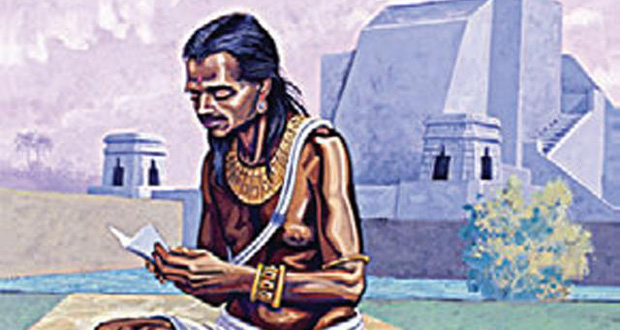7 Brahmagupta
Brahmagupta |
 |
Time period:598 – 668 CE Subject:Mathematics and Astronomy |
|
Biography:Brahmagupta self-identifies as being born in 598 CE. The exact location of his birth is disputed, but we know that at the age of 30, he was a resident astronomer at a school called Brahmapaksha. After the publishing of Brāhmasphuṭasiddhānta, he moved to Ujjain school. Late in his life at the age of 67, he published his second book titled Khanda-khādyaka, a guide on practical astronomy intended for students. After his death in 668 CE, his publications were shared across Arabia and Europe. To this day, Brahamgupta remains one of the most important and influential contributors to mathematics and astronomy.
|
|
Summary of their contributions:His landmark book, Brāhmasphuṭasiddhānta, contained insights across many fields of science and math. It offered the first written guidance on how to use the number zero and negative numbers, discussed gravity as an attraction force, and even showed the first solution to the quadratic equation. He also proved that the Moon was closer to the Earth than the Sun using a revolutionary way of calculating the position of celestial bodies. His works paved the way for Newton, al-Khwarizmi, and many others to develop modern science and math.
|
|
Integration with the BC Secondary Science Curriculum:The work of Brahmagupta can be easily discussed in two main areas: Science 10 and Physics 11. In Physics 11, discussion of his observations provides an excellent introduction to the topic of gravity. One of the key curricular competencies in for students to make observations aimed at identifying their own questions about the natural world. In the 6th century, Brahmagupta was only able to observe the physical world around him with his sense. He did not have the modern tools or understanding, but was able to formulate multiple hypotheses and predict outcomes. In Science 10, students are expected to know astronomical collection methods. While much of the focus will be on modern technologies, revisiting the ancient techniques of Brahmagupta, and how he measured the position of the Moon, would help students apply other ways of knowing. Reading a translation of his writing would also introduce students to diverse ways of communicating scientific ideas, as all of his work was written as poetry.
|
|
References:Bīrūnī, Muḥammad ibn Aḥmad, Alberuni’s India London : Kegan Paul, Trench, Trübner & Co., 1910.Electronic reproduction. Vol. 1 and 2. New York, N.Y. : Columbia University Libraries, 2006. JPEG use copy available via the World Wide Web. Master copy of vol. 1 stored locally on [3] DVDs#: ldpd_5949073_001 01, 02, 03. Master copy of vol. 2 stored locally on [3] DVDs#: ldpd_5949073_002 01, 02, 03.. Columbia University Libraries Electronic Books. 2006. Hoffman, Brittany. “Brahmagupta – Mathematician Biography, Contributions and Facts.” Famous Mathematicians, www.famousmathematicians.net/brahmagupta/. Accessed 7 Dec. 2023. Pearce, Ian G. “The Classical Period: III. Brahmagupta, and the Influence on Arabia.” Maths History, mathshistory.st-andrews.ac.uk/Projects/Pearce/chapter-11/. Accessed 7 Dec. 2023. Pickover, Clifford A. “Newton Law of Universal Gravitation, 1687.” Archimedes to Hawking Laws of Science and the Great Minds behind Them, Oxford University Press, Oxford, 2008, p. 105. |
|

